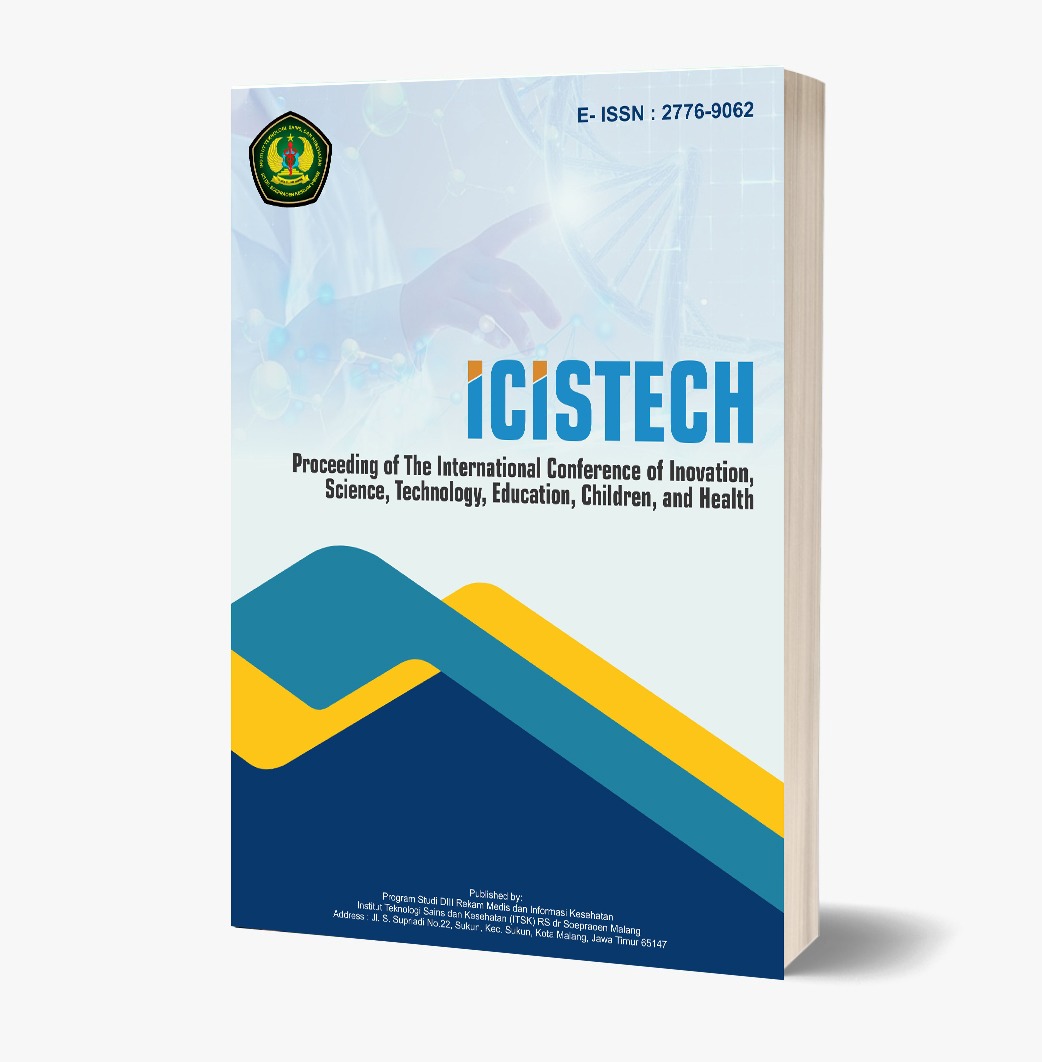The Influence Of Medical Officer Knowledge And Facilities Of Medical Recording Documents On Inaccuracies Of Main Diagnosis Codes According To Icd-10 In Medical Record Documents At dr. Soepraoen Hospitals Malang
DOI:
https://doi.org/10.62951/icistech.v1i1.15Keywords:
medical officers, knowledge, ICD-10, medical recordAbstract
The competence of a medical recorder is to code diagnosis. But in the fact, there are still many medical officers who experience some difficulties in coding diagnoses quickly, precisely, and accurately. This study is here to find out the effect of the knowledge of medical personnel and medical record document facilities on the inaccuracy of the main diagnosis code according to ICD-10 in the medical record document at dr. Soepraoen Malang. This research uses a qualitative method with a case study approach design. The location of this research is DR. Soepraoen Hospital, Malang. Processing data in this study is use non statistic. The result of this study is there is a negative and significant effect of health workers knowledge partially on the inaccuracies of main diagnosis codes, there is a negative and significant effect of hospital facilities partially on the inaccuracies of main diagnosis codes, there is a simultaneous negative and significant effect of health workers knowledge and hospital facilities on the inaccuracies of main diagnosis codes.
References
Departemen Kesehatan RI. (1996). Peraturan Pemerintah No. 32 Tahun 1996 tentang Tenaga Kesehatan. Jakarta.
Departemen Kesehatan RI. (2008). Profil kesehatan Indonesia 2007. Jakarta : Depkes RI Jakarta
Hatta, G, R, (2008). Pedoman Manajemen Informasi Kesehatan di Sarana Pelayanan Kesehatan. UI-PRESS.
Hatta, G. 2010. Pedoman Manajemen Informasi Kesehatan di Sarana Pelayanan Kesehatan. Jakarta: UI-Press
Indonesia, R. (2014). Peraturan Menteri Kesehatan no 27 tahun 2014 tentang Petunjuk Teknis Sistem Indonesian Case Base Groups (INA–CBGs).
Khabibah, S., & Sugiarsi, S. (2013). Tinjauan Ketepatan Terminologi Medis dalam Penulisan Diagnosis pada Lembaran Masuk dan Keluar di RSU Jati Husada Karanganyar. Jurnal Manajemen Informasi Kesehatan Indonesia, 1(2), 46-52.
Kresnowati, L. (2005). Hand out ICD-10. Universitas Dian Nuswantoro, Semarang.
Oktamianiza. 2011. Analisis Keefektifan Pengelolaan Informasi Kesehatan Berdasarkan Sistem Casemix INA-CBG’s Pasien
Jamkesmas pada Bangsal Bedah di RSUP Dr. M. Djamil Padang Tahun 2011. Karya Tulis Ilmiah (Tidak Dipublikasikan).
Padang: Program S2 Kesehatan Masyarakat Universitas Andalas Padang.
Pamungkas, T. W., & Marwati, T. (2012). Analisis Ketidaklengkapan Pengisian Berkas Rekam Medis di Rumah Sakit PKU Muhammadiyah Yogyakarta. Jurnal Kesehatan Masyarakat (Journal of Public Health), 4(1), 17-28.
Rivany, R. (2008). Clinical Pathway Sectio Caesaria & Diare Rumah Sakit Tarakan & RS Budi Asih [Disertasi]. Jakarta: Department of Health Policy and Analysis, SPHUI.
Sugianto, Z. (2005). Perilaku Dokter Dalam Mengisis Kelengkapan Data Rekam Medis, RSU Ungaran (Doctoral dissertation, Tesis).
Undang-Undang Republik Indonesia Nomor 36 Tahun 2014 Tentang Tenaga Kesehatan.
Yuliani, N. (2010). Analisis Keakuratan Kode Diagnosis Penyakit Commotio Cerebri Pasien Rawat Inap Berdasarkan ICD-10 Rekam Medik di Rumah Sakit Islam Klaten. Infokes (Jurnal Ilmiah Rekam Medis dan Informatika Kesehatan), 1(1), 17-31.
WHO. 2004. International Statistical Classification of Disease And Related Health Problems, Tenth Revision. Geneva: WHO.
Wibowo. (2008). Manajemen Kinerja. Jakarta. Penerbit: Rajagrafindo Persada.
Davis, K. A., Sudlow, C. L., & Hotopf, M. (2016). Can mental health diagnoses in administrative data be used for research? A systematic review of the accuracy of routinely collected diagnoses. BMC psychiatry, 16(1), 1-11.
Karaca, A., & Durna, Z. (2019). Patient satisfaction with the quality of nursing care. Nursing open, 6(2), 535-545.
Thompson, G., O’Horo, J. C., Pickering, B. W., & Herasevich, V. (2015). Impact of the electronic medical record on mortality, length of stay, and cost in the hospital and ICU: a systematic review and metaanalysis. Critical care medicine, 43(6), 1276-1282.
Gillum, R. F. (2013). From papyrus to the electronic tablet: a brief history of the clinical medical record with lessons for the digital age. The American journal of medicine, 126(10), 853-857.
Gottlieb, L. M., Tirozzi, K. J., Manchanda, R., Burns, A. R., & Sandel, M. T. (2015). Moving electronic medical records upstream: incorporating social determinants of health. American Journal of Preventive Medicine, 48(2), 215-218.
Aisyah, E. N., Iriyanto, T., Astuti, W., & Yafie, E. (2019). Pengembangan Alat Permainan Ritatoon Tentang Binatang Peliharaan sebagai Media Stimulasi Kemampuan Kognitif Anak Usia Dini. Jurnal Kajian Teknologi Pendidikan, 2(3), 174-180.
Downloads
Published
How to Cite
Issue
Section
License
Copyright (c) 2024 Proceeding of The International Conference of Inovation, Science, Technology, Education, Children, and Health

This work is licensed under a Creative Commons Attribution-ShareAlike 4.0 International License.













